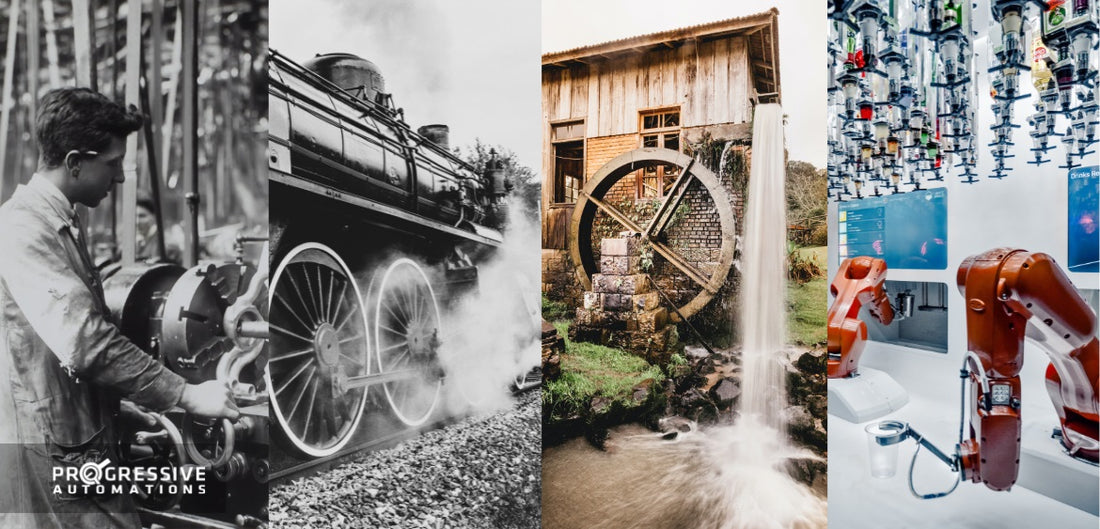Throughout the history of automation, the emergence of newer techniques, processes and machines eventually shaped a path for automation to play a larger role in our society. The main goals for the evolution of automation in everyday life has been to help improve efficiency, productivity, safety, and convenience. In this article, we will cover the history of industrial automation to gain a better understanding of how the different stages of automation’s evolution have developed and advanced to the technologies we use today.
History of Automation in Manufacturing

Since the beginning, everyday people and business owners have always looked for different ways to improve efficiency in day-to-day tasks. In ancient times, our ancestors did most of their work manually with the assistance of simple machines, pulleys, levers, hand tools, and sometimes working animals. From a manufacturing standpoint, production processes are typically categorized as:
- Fully manual
- Semi-automated
- Fully automated
By reducing the amount of human intervention required to perform a task, processes such as manufacturing become much more efficient through automation. The history of automation’s timeline covers how technology has advanced through the evolution of automation.
1st Century BC: Water Wheels
The true date of origin for water wheels is difficult to confirm, however, they became more common use by the Greeks and Romans for grinding grain into flour around the 1st century BC. Other simpler machines which date back much earlier still required a fair amount of human intervention or animal labor to work. The utilization of falling water from watermills to drive a mechanical process can be viewed as the beginning of “semi-automation” and the early stages of automation evolution.

Early water wheels
9th Century: Mill Machinery Advancements
Watermills and windmills are both a type of mill machinery that uses renewable energy to drive a mechanical process. The earliest recorded design of a windmill for practical use originates around the 7-9th century and was made by the Persians. These windmills were also used to grind grain and then later developed for many other mechanical processes.
Although watermills can offer more power for its size, windmills were usable in regions which had no flowing water available. Both technologies continued improving and were being adopted across the globe to reduce the manual labor required in:
- Hammermills
- Sawmills
- Paper mills
- Ore-crushing mills
- Tool-sharpening mills

Early windmills
17th to 18th Century: Industrial Revolution
Originating in Western Europe, the 17th century industrial revolution was a major turning point in the evolution of industrial automation. During this era, the invention of steam engines, steam mills and internal combustion engines had mostly replaced the need for watermills and windmills. In 1785, Oliver Evans had also developed an automatic flour mill which was history’s first completely automated industrial process by being able to have continuous production without any human intervention.

Early manufacturing factories
In 1867, James Clerk Maxwell published a paper establishing the beginnings of a theoretical basis for understanding control theory. Industrialized factories continued being adopted to mass produce materials such as cotton, paper, plastics, glass, and metals in much higher volumes with greater efficiency. As the technology and processes of the industrial revolution had spread across the globe, the economy, transportation, health, and medicines worldwide were all growing exponentially.

Steam engines for locomotives
1900 to 1950s: Electrification & Industrial Controllers
Around the 1920s, the evolution of industrial automation accelerated rapidly as factories began making use of relay logic and underwent electrification - the process of powering by electricity. Expanding use of central electric power stations combined with the operation of new high-pressure boilers, electrical substations and steam turbines resulted in a growing demand for instruments and controls.

Electrical power distribution
Manufacturing plants started transitioning to electric motors and fewer facilities continued with front line shaft and belt drives using steam engines. During this transition, manufacturing facilities experienced about 30% increases in output. This was because electric motors had much greater efficiency compared to steam engines, required less maintenance, and did not experience the high friction losses from line shafts and belts.

Early electric motors
Color-coded lights from control rooms were required to send signals for factory workers to make manual changes such as opening or closing valves and turning switches on or off. This is a type of process control known as “on-off”. In the 1930s, controllers were introduced into the industry to enable calculated changes as a response to disturbances from the set point. Solid-state digital logic modules for hard-wired programmed logic controllers were being adopted by industrial control systems for process control and automation in 1958. As the predecessors of programmable logic controllers (PLC) used today, they gradually replaced most of our needs for electro-mechanical relay logic.

Early control stations
20th to 21st Century: Computers & Robotics
In 1971, the invention of microprocessors resulted in large price drops for computer hardware and allowed the rapid growth of digital controls in the manufacturing industry. Our constant advancements in computer technology up till this day continues to advance the evolution of industrial automation. With digital computers, manufacturing facilities were now able to have controllers which can perform more complex tasks at faster speeds and greater efficiency.

Introduction of computers
As technology continued in advancements, the evolution of robotic process automation was becoming more prominent in manufacturing facilities. Victor Scheinman, an American pioneer of the robotics field had invented the “Stanford arm” in 1969. It was designed to permit an arm solution as a 6-axis articulated all-electric robot. This shaped a path for robots to have the potential of performing more complex tasks such as welding and assembly. In 1973, Europe was making huge advancements in industrial robotics by bringing robots to the market through ABB Robotics and KUKA Robotics.
The robots in today’s factories are now used for almost every existing assembly and manufacturing process. Not only do robots remove humans from hazardous environments, but they also help lower costs for business owners to stay competitive by increasing energy efficiency, productivity, accuracy, and precision for better production quality. We can now see the evolution of robotic process automation in processes such as:
- Glass manufacturing
- Pulp and paper mills
- Food and beverage processing
- Automotive assembly
- Natural gas separation
- Electrical power generation
- Electronics manufacturing
- Canning and bottling

Robotics in manufacturing factories
Evolution of Home Automation

The evolution of automation in everyday life is most noticeable when we get to experience it in our homes daily. As electrification started growing in the 19th century, it has been estimated that 70% of U.S. households were electrified around 1930. Electrical power distribution led to the potential for homeowners to have a means of powering early home appliances such as:
- Water heaters
- Clothes dryers
- Dishwashers
- Refrigerators
- Vacuum cleaners
- Washing machines
- Sewing machines

Home water heating
Although many of these home appliances started out being too expensive for most households, the gradual introduction into the market combined with improving technologies eventually made them more affordable.
In the 1970s, the large drop in price for computer hardware resulted in the price of electronics to drop significantly. This allowed domestic appliances to be more accessible for home uses. In the 1990s to 2000s, internet technology was developing significantly. This allowed for smart homes to become more affordable, resulting in an increase in popularity for home automation. Home automation can be easily found in today’s modern homes with smart technologies such as automatic lights, HVAC controls, safety & security systems, TV lifts and entertainment controls. All these smart technologies are now something we can conveniently access through a smart phone with the compatible smart home apps. With working from home becoming more common practice, we have also seen a rise in demand for electric standing desks.

Smart home - lights and entertainment controls
In Summary
The evolution of automation in everyday life has been going on throughout history and will continue making its way in future generations. As our technology makes future advancements, we can now expect to see the evolution of robotic process automation making a greater impact in our industry.
We hope you found this as informative and interesting as we did, especially if you were interested in the history of industrial automation. If you have any queries or wish to discuss our products further, please do not hesitate in reaching out to us! We are experts in what we do and will be happy to assist in any way we can.
sales@progressiveautomations.com | 1-800-676-6123




